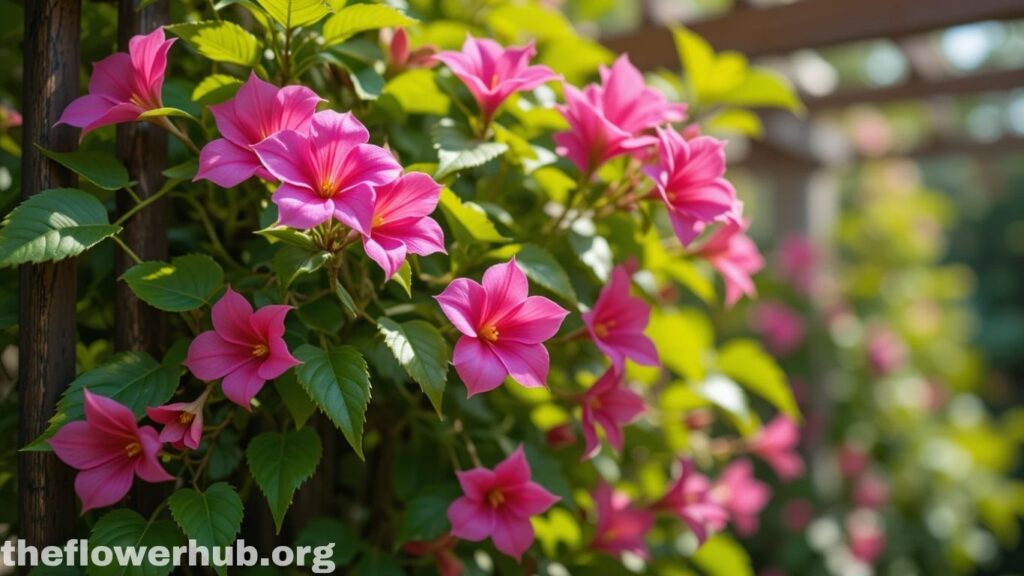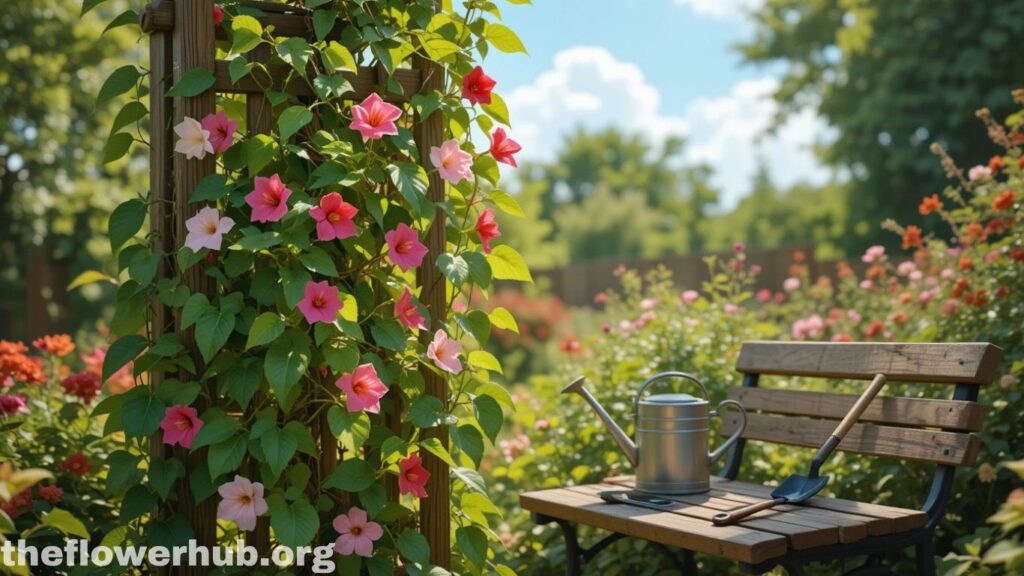Mandevilla is a popular tropical vine prized for its large, trumpet-shaped flowers in brilliant shades of red, pink, yellow or white. This ornamental climbing vine is the tropical plant you’ve been looking for to liven up patios, balconies or even indoor gardens. For that reason, we’re sharing ten mind-blowing, lesser-known facts and trivia that all plant lovers need to know! Ranging from when it was first discovered to how to care for it, every single one of these amazing facts show us that the plant is not only a beautiful flower.
Table of Contents

Quick Facts Table
| Attribute | Details |
|---|---|
| Common Name | Mandevilla |
| Botanical Name | Mandevilla spp. |
| Family | Apocynaceae |
| Native | Central and South America |
| Flower Colors | Pink, Red, White, Yellow |
| Sun | Full Sun to Partial Shade |
| Water | Moderate |
| Soil | Amended, rich, well-draining |
| Growth | Climbing, vine |
| USDA Hardiness Zones | 9–11 (as a perennial), 4–8 (as an annual) |
A Tropical Climber With Global Appeal
Native to the tropical areas of Central and South America, mandevilla has stolen the hearts of gardeners around the globe. With its exotic appearance and an impressive ability to climb trellises, walls and railings, takes top billing in the world of vertical gardening. This lovely climbing treasure will bring a stunning bit of nature into any spot where it grows and does best in warm.
It Was Named for a British Diplomat
Mandevilla The common name ,honors Henry Mandeville, a 19th century British diplomat and garden buff. The genus was named after his name as his work in horticulture earned him the honor. This special name not only celebrates the plant’s rich history but also nods to the plant’s obsession factor that has always been the allure for plant hoarders and botanists.
Flowers Frrom Spring to Fall
2 What makes mandevilla so appealing is its long season of bloom. Late spring to early fall, the plant awakens with vivid blossoms that are a feast for the eyes during its months of growth. They have large, flashy flowers, and they give you the most consistent color at a time when most other plants have all but given up on flowering.
There Are More Than 100 Types
And although most gardeners are familiar with the traditional red and pink flowering vines, there are more than 100 species and hybrids. Each type has something special to offer — ranging from the shape, structure or size of the flowers to growth habits and statures. Known hybrids include ‘Alice du Pont’, ‘Sun Parasol’, and ‘White Delight’.
It Prefers a Warm, Sunny Spot
Its thrives in full sun to part shade and hot weather. It is most beneficial grown outside in USDA zones 9–11, yet it can be grown in cooler climates in pots and brought indoors over winter. Keeping the plant well-lit is also key to encouraging the bold blooms.
Chilean Jasmine Is a Low-Maintenance Beauty
It has a tropical appearance, but surprisingly simple care. It needs medium watering, well-drained soil, and a little fertilizer. It’ll take little work to make this beautiful, thriving plant bloom. Unlike other flowers The Morning Glory vine does not require daily care and pruning once it is established.
It can be an annual or perennial
In the warmer zones is a perennial vine that returns year after year. It is an annual in colder regions, where it can be grown inside during cooler months to overwinter. It is often planted in pots, which facilitate full control of temperature and exposure to the sun.
Attracts pollinators
Their blooms attract bees, butterflies and hummingbirds, so are worth the investment. Because of this, It is a great plant for those who want to attract local pollinators to their garden. A space filled is not just beautiful, but buzzing.
Pruning Results in Growth and Flowers
Frequent pruning ensures a shapely mandevilla, but it will also encourage new growth and more flowers. The best time for a hard prune is late winter or early spring so your vine is prepared for the blooming season. Prune out dead stems and those which are too congested to let light and air in to the center of the plant.
It’s Poisonous to Pets If Ate
While it is a showstopper in any garden setting, pet owners be warned. The sap of the plant may be irritant, and ingestion can be toxic to dogs and cats. When you plant be safety conscious, particularly if you have nosy pets. Plant in hanging baskets or large containers if necessary.
How to Grow and Care
While this article is all about the fun facts, it’s also worth exploring what it takes to look after a mandevilla so it blooms the way you hope it will:

Soil and Watering
- Provide ample drainage and organic matter in the soil.
- Moderately, do not overwater to avoid root rot.
- In containers, combine potting soil with peat moss and perlite for improved aeration.
Sunlight and Temperature
- Location Locate in a sunny location with 6 hours of direct light.
- It is frost sensitive; it is also an indoor house plant in cold season in non-tropical zones.
- Maintain temps in excess of 50°F (10°C) so you don’t stress the plant.
Feeding and Fertilizing
- Feed with a general purpose water soluble fertilizer regularly every 2-4 weeks during the growing season.
- Feed less in winter dormancy.
- Time-release fertilizers are also good as they supply much needed nutrition over an extended period.
Support Structures
- Provide trellises or plant next to a fence it can climb on its own.
- Training the vines frequently keeps structure and direction in place.
Pest and Disease Management
- Keep an eye on mandevilla for aphids, whiteflies, and spider mites.
- For mild infestations, consider treating them with neem oil or insecticidal soap.
- Do not waterlog for prevention of fungi.
FAQs
Q1: Is mandevilla winter-hardy outside?
A: Only in USDA zones 9–11. In colder regions mandevilla can be overwintered indoors or enjoyed as an annual.
A2: How often to water a Mandevilla.
A: When the top inch of soil is dry. Do not allow the pot to stand in water, which will cause root rot.
Q3: Does mandevilla require any pruning?
A: Yes, cutting back in early spring produces more blooms and shapes the plant.
Q4: Can mandevilla grow indoors?
A: It does, but it requires bright indirect light and good humidity.
Q5: Can mandevilla be toxic to pets?
A: No, mandevilla is toxic to dogs and cats if ingested.
Q6: Can mandevilla be propagated?
A: Mandevilla is easily propagated with stem cuttings taken in the spring or early summer.
Q7: How quickly does mandevilla grow?
A: In a perfect setting, the mandevilla can get to be 10–15 feet tall in a single season.
Q8: What are common issues with mandevilla?
A: Yellow leaves, powdery mildew and pest infestations are all such common problems, but they’re all manageable with good care.
Q9: Is it possible to use mandevilla as a groundcover?
A: Though mandevilla is a climbing vine by nature, it can set horizontally Dec 12, 2013 Use a trellis, pergola, or arbor as a support or grow the plant on the vertically growing structure of a home or porch.
Q10: Is mandevilla invasive?
A: No, mandevilla generally is not invasive in most areas other than the one garden in which it grows exuberantly.
Conclusion
From its stunning appearance to the low maintenance needed is really a gardener’s dream plant. Whether you want to add color, encourage pollinators or just enjoy a stunning flowering vine plant will give you whatever you need. Drought tolerant and everblooming, with more than 100 varieties and a long season of bloom is as adaptable as it is lovely.
Just pay attention to your plant’s light and temperature requirements, and you can sit back and watch your mandevilla thrive with little effort. Planted with care, since is a tropical vine, it will be brightening up your outdoor (or indoor) spaces for seasons to come.
The fact that it can woo with both beauty and gumption sets apart in any plant lineup. Beginner gardeners have nothing to lose by planting.
